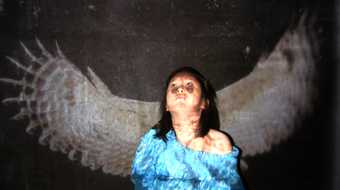It’s not just necks that are curious in Sung Hwan Kim’s works, though there are several of them that are very curious indeed. In one video, he describes a girl whose heart is located in her neck, causing it to throb visibly every time her heart beats. In another, we hear of a woman whose neck is extraordinarily long and filled with snakes. There’s a man whose eyes and nose are just black holes – confusing because he has similar holes all over his face, making him difficult to talk to (where to look when speaking to such a man?). Legs, arms and ears sprout in strange places.
Kim, who grew up in South Korea and is now based in New York, describes these strange characters in his performances and videos, often drawing with a pen as he talks, on tracing paper and transparencies, and regularly accompanied by music. He speaks softly, with almost a slight whisper to his voice, as though confiding a secret, drawing us into his confidence. ‘I know that it doesn’t matter if things are true or not, but this is a true story,’ he says at the beginning of his film From the Commanding Heights 2007, before launching into the story about the woman with the snake-filled neck. This sense of ‘truth” is clearly an altered one, but it’s an interesting quirk of language that when someone tells us that what we are hearing is a true story, it changes the way we receive it, even if what we hear is utterly fantastical. It has a sense of truth to it.
The second story in From the Commanding Heights is almost believable, however. We are shown the block of flats in Seoul that Kim grew up in, which, he says, was blighted with constant powercuts. Rumour had it that the reason for these was an affair between the president, Park Chung-hee, and a beautiful actress who lived in the building – apparently, he would order blackouts so he could enter under cover of darkness. One gets the sense from this story that the actress has little choice in the matter of the affair, and that she is somehow connected to the woman with the snakes in her neck. The darkness creates an image of an ominous, monolithic power, and the lack of control one has when faced with it, as well as an overwhelming feeling that a vast underlying lagoon of tragedy is being hinted at – an effect that is ramped up by the powerful, mournful songs and musical accompaniments on the film provided by Kim’s regular collaborator David Michael DiGregorio (also known as dogr).
Living in South Korea until 1996, Kim experienced a life under an authoritarian rule, and the distorting sense of such authority can be seen in other works, particularly Dog Video 2006. He plays the part of his own strict father, while DiGregorio plays variously the young Kim and the part of a dog. The father barks contradictory orders at the dog boy – ‘Come up! Go down’ – seemingly playing the martinet for the sake of authority itself.
It’s perhaps worth considering the distortion of the bodies in Kim’s stories in light of his interests in authority and power and the exploited or powerless: the idea that oppression breeds creatures who are not allowed to flourish. One might even go as far as to say that the mutated, surreal necks – the point at which the head of the state meets the body of the state – are a metaphor for this power relation. And yet there is something else here too. The artist’s choice of presentation takes a decidedly anti-authoritarian approach. He constantly emphasises possibility, change and improvisation, as well as mental freedom, and it seems that live drawing is an important way of communicating this. A line can go anywhere, as can a story: the constraints of reality do not apply, anything is possible and hearts and snakes can live inside necks. When he performs on stage with DiGregorio, he often asks questions, as though they are a band chatting between songs at a gig. Although these conversations are not improvised, they are delivered haltingly and thoughtfully, as if they are.
In Manahatas Dance 2009 Kim describes how in hell every person will be put into a volcano the size of their body, with their head sticking out of the top and a lava flow under their chins – a disturbing thought, and yet when we later see three people dancing, wearing brightly coloured volcano-shaped costumes, they laugh and arrange themselves in a kind of clean, New York-inflected version of a Lygia Pape performance. ‘We will harness the sun, the wind, the soil to fuel our cars and run our factories,’ sings a voice, as we watch young Americans jumping up and down, lithe and energetic (the lyrics are taken from Barack Obama’s inauguration speech). ‘The sun was to have broken through. And then night sets in,’ Kim says quietly near the end of the video. Such a lightly drawn expression of the mechanics and surrealities of power, the bounding, boundless optimism of potentiality and beauty, and the tender sadnesses of reality are the specialities of Kim’s moving, very particular language. Beautiful and strange as a girl with her heart in her neck.

